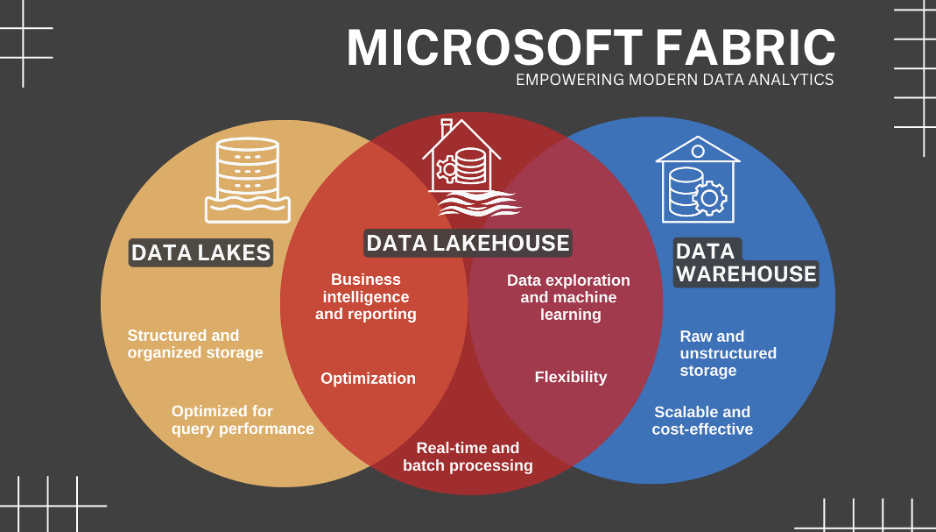Microsoft Fabric: Empowering Modern Data Analytics

The landscape of modern data analytics has evolved over time, with players like Snowflake, Amazon RedShift, and Microsoft’s Microsoft Fabric paving the way. However, implementing these solutions often involved intricate planning and managing disparate tools. Introducing Microsoft Fabric – a holistic solution engineered to streamline and harmonize contemporary analytics workflows. With Microsoft Fabric, complexity gives way to efficiency, a significant step forward in the world of modern analytics.
Microsoft Fabric is designed to help organizations optimize data storage, processing, and analysis to utilize these as a form of reliable assistance to your strategizing and decision-making. Microsoft Fabric is scalable, reliable, and flexible – it offers different types of data warehouse architecture such as data warehousing, data lakes, and Data Lakehouse – each customized with its own set of features to suit the diverse needs of organizations and enterprises.

Data Warehousing: Actionable Insights from Data
Data warehousing is the process of sourcing data from multiple distinct sources and integrating them to build your own data warehouse. A structured approach to data management and data warehousing helps you draw out analytical reports, answer queries, and make better organizational and business decisions. With the use of Microsoft Fabric, data warehousing is made more efficient by enabling better data movement, transformation, and integration.
Microsoft Fabric assists organizations in streamlining their process of aggregating and analyzing data. Azure also ensures high performance and scalability especially when handling a continually increasing volume of data. With top-of-the-notch data analytics performance, Microsoft Fabric has the capability to handle complex queries, generate insights, and deliver timely reports to business users to provide them with possible solutions.
Data Lakes: From raw to structured
Data Lakes is another service that you can access through Microsoft Fabric. Data lakes serve as repositories where one can store structured, semi-structured, or unstructured data in its raw format. With Microsoft Fabric, users can expect efficient data ingestion, storage, and processing capabilities. Massive amounts of data, in any type of format, are pooled into a single location so these can be easily accessed for analysis by various frameworks. Because of these features, Microsoft Fabric is an ideal infrastructure for data lakes.
Microsoft Fabric powers Azure Data Lake Storage Gen2, which offers users advanced features like hierarchical namespace, low-cost storage, and high throughput. Storage, management, and analysis of vast amounts of data are made more efficient within the data lake and can be readily utilized by organizations for purposes that help their goals. In addition, Microsoft Fabric powers the Azure Data Factory, a fully managed integration service that makes it possible to move data from various sources into the data lake. It takes your data in a series of processes turning them from raw to products that you can make good use of.
Data Lakehouse: The combined power of Data Lake and Data Warehouse
Data Lakehouse combines the best aspects of data warehousing and data lakes. It provides a unified platform where data management can be done in an optimized way giving organizations the power to leverage structured and unstructured data seamlessly.
Microsoft Fabric allows organizations to process data using familiar SQL-based queries, on top of using big data tools like Apache Spark. The optimized data movement capabilities that come with Microsoft Fabric’s data architectures ensure efficient data loading, transformation, and querying. All of these are done in a Lakehouse environment which derives valuable insights from diverse data sources. Through this infrastructure, users can be assured that the data they input is thoroughly analyzed, and relevant conclusions are made.

Why would Fabric replace other Modern Data platforms?
While Microsoft Fabric is still finding its way to becoming a household name among tools for data management, it already has much potential to compete with existing cloud platforms. Here are some reasons why users have switched to Microsoft Fabric, and why more are following suit:

1. Integration with Azure and Microsoft Ecosystem: Microsoft Fabric, as part of the Azure Ecosystem, is designed to seamlessly integrate with other existing Microsoft products and services. This offers a competitive advantage to those who already make use of the Microsoft ecosystem. An integrated system could also encourage non-Microsoft users to consider switching. After all, this type of integration makes data sharing management, and analytics much smoother for better results.
2. Unified Analytics and Data Integration: For simplified data workflows, Microsoft Fabric gives you that much-needed harmony. With unified systems, you can find a comprehensive solution for data analytics and integration for your organization. In just a single platform, you can combine analytics, data storage and integration. This is a great way of enhancing your overall efficiency, letting you handle more complicated tasks in just a few clicks.
3. Performance and Scalability: Microsoft Fabric helps you make it bigger. With use, users and experts have noticed superior performance and scalability with Fabric compared to other cloud platforms. A high-powered tool like this would prove very integral to businesses and organizations especially as the world treads the path of the digital age. Demanding workloads are now responded to, and very well at that, by high-speed processing. Your business’ growth potential is realized!
4. Security and Compliance: Worrying about data leaks? Microsoft Fabric provides robust security features and compliance certifications that it shares across the entire Azure ecosystem. With a strong suit of security features, organizations can be assured that the data they handle is safe.
5. Support and Documentation: Switching and transitioning to a new tool can be much of a challenge for most of us. But with the comprehensive support and documentation, and a thriving user community that can help you out, Microsoft Fabric eases you into the ecosystem, letting you master it in no time.
There are many other factors to consider when appraising Microsoft Fabric such as the more specific features, actual performance, cost-effectiveness of pricing, and reliability that we still have put to test. But as early as now, it’s very promising with how it provides enterprises with results, making it a formidable competitor with AWS, Google Cloud and other cloud services. Make sure to keep your eyes peeled as Fabric rolls out new and improved features soon.
How to best utilize Microsoft Fabric (our Blueprint)
1. Understand the Offering: Maximization begins with a thorough understanding of what the tool offers. You can start by looking at the features, capabilities and services that come with the package. This task ranges from reading official documentation, watching tutorials, browsing the internet for reviews, and attending peer training sessions.
2. Assess Your Needs: A careful evaluation of what your organization needs sets the tone of how you will optimize Microsoft Fabric for maximized use. Here, you identify the areas where it can help you – take for example, data storage, analytics, integration or application deployment. For the purposes of your specific organization, you also have to align your expected business intelligence outcomes to optimally set up how Fabric should operate.
3. Plan Your Migration: A migration plan lets you look deeper into your objectives and align them to how you’re going to migrate and populate your data infrastructure. Typically, this plan will outline what needs to be moved, when and how. In migrating data, some factors that have to be considered to make it foolproof are application compatibility and possible downtimes from time to time.
4. Design for Scalability: Cloud storage is relatively flexible and scalable. And you should make good use of that characteristic. Your applications and infrastructure must comply with a design that you scale up or down based on the actual demands of your processes. When this is done, costs are optimized, and a consistent performance is assured.
5. Security and Compliance: In business enterprises and other types of organizations, there are security and compliance requirements that must be met. They differ depending on the specific type of work, area and industry. It must be made sure that Microsoft Fabric also aligns with these. In case there are gaps, appropriate security measures must be implemented in addition to protecting your data and applications.
6. Cost Optimization: Usually, cloud platforms over plans and pricing models which delineate the specific features that are included. Study your needs well and monitor your usage so you can choose your preferred plan or adjust your resources as needed.
7. Leverage Integration: Initially, Microsoft Fabric offers seamless integration with other Microsoft services and with the Azure ecosystem. In the future, more third-party apps will be available for integration. You should also take these into consideration because a more streamlined process can be attained if you leverage the integration of your workflow.
8. Training and Support: Transitioning to another tool not only involves data and the infrastructure. Those who will use it must also be trained to handle the software to use it to the maximum potential. Your team must be provided training materials, tutorials and access to support resources to develop their familiarity and mastery.
9. Regularly Update and Monitor: Because of its dynamic nature, Microsoft Fabric issues updates and patches. Be sure to keep your applications up-to-date for the most efficient performance. These patches address bugs or issues. In case you encounter these, you should also report them to appropriate channels for further resolution, and consideration in the next updates.
10. Experiment and Innovate: Microsoft Fabric offers you the power to break new ground. Its flexibility and allowance for experimentation can be a great start to test new ideas, develop prototypes and innovate what your organization can do.
11. Manage all types of data workloads: You can also diversify Microsoft Fabric’s applications. Data engineering, data science, real-time analytics, IoT workloads, and other AI and machine learning applications are just some of the recommendations on top of mind.
Our perspective on Microsoft Fabric
The technical prowess of Microsoft Fabric highlights the versatility and scalability it has that addresses the concrete needs of modern data management architectures. Microsoft Fabric proves to be robust in handling large volumes of data, a fact that is often commenced by users working with data-intensive workloads.
A recent Forrester Research study stated that the Microsoft Fabric-powered Microsoft Fabric has helped organizations achieve a 331% return on investment (ROI) over three years of use. The same study suggests increased productivity and cost savings that were achieved using Microsoft Fabric in data management strategies.¹
However, we would recommend the need for proper data governance and management to fully optimize the benefits that Microsoft Fabric can bring. Although the tools are highly powerful and capable in themselves, organizations are advised to implement appropriate data governance policies and practices to ensure data, quality, security, and compliance. This is a complex matter beyond the suite of tools that organizations must put time, effort, and resources into.
https://thinkaicorp.com/microsoft-fabric-empowering-modern-data-analytics/

Comments
Post a Comment